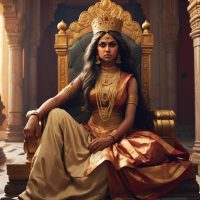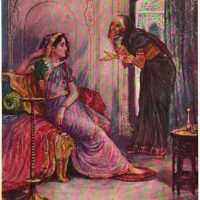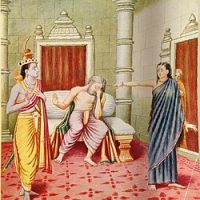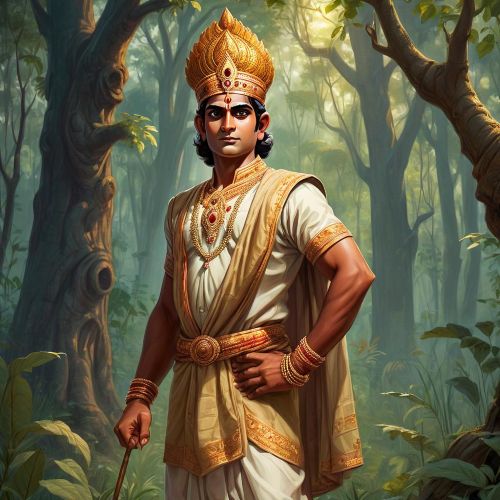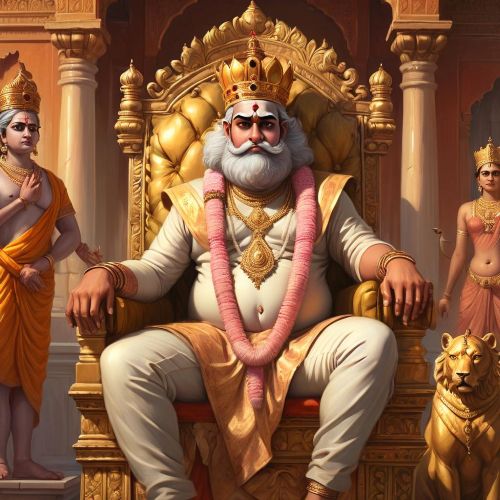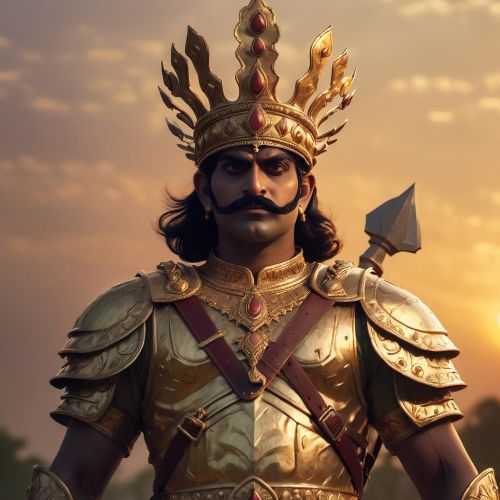Kaikeyi : The Warrior Queen
Listen
At a glance
| Description | |
|---|---|
| Origin | Indian Mythology |
| Classification | Mortals |
| Family Members | Ashvapati (Father), Dasharatha (Husband), Bharatha (Son) |
| Region | India |
| Associated With | Battle, Royalty |
Kaikeyi
Introduction
Kaikeyi, one of the most pivotal figures in the Ramayana, remains a character whose actions altered the course of Ayodhya’s destiny. As King Dasharatha’s second and most beloved wife, and the mother of Bharata, Kaikeyi’s choices led to the exile of Prince Rama and set into motion the chain of events that defined one of India’s greatest epics. Though often portrayed as the instigator of Rama’s exile, her motivations are far more layered than mere jealousy or ambition. Scholars and storytellers have long debated her true intentions—was she driven by maternal love, political foresight, or the influence of manipulation? The character of Kaikeyi thus stands at the intersection of devotion, duty, and moral complexity, embodying the dilemmas that define human nature and royal responsibility.
Physical Traits
The Ramayana does not linger on Kaikeyi’s physical appearance, yet various interpretations present her as the embodiment of royal grace and elegance. Described in later retellings as fair-skinned, poised, and radiant, Kaikeyi carried the beauty and confidence befitting a princess of Kekaya. Raised in a warrior kingdom, she possessed both charm and strength, qualities that made her a beloved consort to King Dasharatha. Her demeanor combined gentleness with a commanding presence, and she is often portrayed in paintings and temple art adorned with gold ornaments and fine silks, symbolizing both her regal heritage and her role as the favored queen of Ayodhya.
Family
Born to King Ashvapati of the Kekaya kingdom, Kaikeyi was raised in an environment that valued intellect, strategy, and courage. Her father, known for his wisdom, ensured that his daughter was not only well-educated but also skilled in the art of warfare—a rare accomplishment for a royal woman of her time. After marrying King Dasharatha of Ayodhya, Kaikeyi became one of his three queens alongside Kausalya and Sumitra. Her son Bharata was deeply devoted to his half-brothers, particularly Rama, reflecting the initial harmony within the royal household. However, this familial peace was disrupted when Kaikeyi, influenced by her maid Manthara, demanded that Rama be exiled for fourteen years and Bharata be crowned king. Despite her controversial decisions, Kaikeyi’s love for her son remained sincere, even if her actions were misguided.
Other names
Kaikeyi’s name derives from her homeland, the Kekaya kingdom, symbolizing her noble lineage and identity. In various regional versions of the Ramayana, she is also known as Kekayi, Kekayi Devi, or simply Bharata Mata—the mother of Bharata. Her titles within the royal court, such as Rani Kaikeyi or Queen of Kosala, emphasize her prominence and influence. In folk and devotional retellings, she is sometimes invoked with reverence for her role in shaping the destiny of Rama and Ayodhya, while in others, her name carries the weight of moral caution. The multiplicity of these titles reveals how different traditions have interpreted her legacy through contrasting moral lenses.
Powers and Abilities
Unlike divine beings in the Ramayana, Kaikeyi was entirely human, yet she wielded extraordinary influence derived from her intelligence, courage, and the two boons granted to her by Dasharatha. These boons, earned when she once saved the king’s life during a fierce battle, allowed her to make any two wishes at any time. Years later, manipulated by Manthara’s cunning words, Kaikeyi used these boons to demand Rama’s exile and Bharata’s coronation.
Kaikeyi’s true “powers” were her strategic mind and emotional strength. She was skilled in warfare and horsemanship, attributes inherited from her royal upbringing. More than physical prowess, it was her decisiveness and political awareness that made her a formidable figure in Ayodhya’s royal court. However, her downfall lay not in malice but in misjudgment—her inability to foresee the emotional and spiritual consequences of her choices. While her actions led to immense sorrow for Dasharatha and Rama, they also paved the way for the fulfillment of divine prophecy and Rama’s eventual triumph over evil, giving her decisions a cosmic significance that transcends human morality.
Modern Day Influence
Kaikeyi’s story continues to resonate deeply in modern culture, where her character is often reinterpreted to reflect evolving views on power, motherhood, and agency. In traditional narratives, she was often cast as the antagonist—a queen whose ambition and manipulation brought about suffering. However, modern scholarship and feminist reinterpretations have sought to understand her motives within the constraints of patriarchy and royal duty.
In literature and media, Kaikeyi’s image has undergone a transformation. Novels like Kaikeyi by Vaishnavi Patel reimagine her as a visionary leader—a woman of intellect and independence who sought to protect her son and kingdom through calculated decisions. In television and film adaptations of the Ramayana, such as Ramanand Sagar’s iconic series and modern reinterpretations, Kaikeyi’s emotional struggle is portrayed with empathy, highlighting her internal conflict between love for Rama and loyalty to Bharata.
Performing arts like Ram Lila, Kathakali, and regional folk plays often present Kaikeyi as a tragic heroine rather than a villain. Her story serves as a reminder of how power, persuasion, and maternal love can intertwine to create complex moral outcomes. In moral education and discourse, her actions are discussed as lessons on how even noble intentions can lead to unforeseen suffering when clouded by emotion and poor counsel.
In modern discussions on gender and leadership, Kaikeyi is viewed as a woman who dared to assert her will in a deeply patriarchal society. Her decision-making power, though controversial, represents an early example of female agency in mythic literature. The reinterpretation of Kaikeyi as a multifaceted woman—neither wholly righteous nor entirely blameworthy—reflects the growing appreciation for nuanced female characters in Indian mythology.
Kaikeyi’s story continues to inspire writers, artists, and thinkers who explore the shades of morality, ambition, and love. Her legacy, once confined to the role of the antagonist, now embodies a universal truth about human emotion and the unintended consequences of choices made in the name of love and loyalty. In this light, Kaikeyi remains one of the most compelling figures in the Ramayana—a queen whose heart, though flawed, was profoundly human.
Related Images
Source
Wikipedia contributors. (2024). Kaikeyi. Wikipedia. https://en.wikipedia.org/wiki/Kaikeyi
Avid Archer. (2024, August 6). Kaikeyi: The Misunderstood Queen of Hindu Epic. https://avid-archer.com/kaikeyi-the-misunderstood-queen-of-hindu-epic/
Vohra, S. (n.d.). Kaikeyi Unveiled: A Complex Character from the Ramayana. Boloji. https://www.boloji.com/articles/54513/kaikeyi-unveiled-a-complex-character-from-the-ramayana
Patel, V. (2022). Kaikeyi. Redhook Books.
Chakravarti, U. (1987). The Social Dimensions of Early Buddhism. Oxford University Press.
Dutt, M. N. (1891). The Ramayana (Vol. 1–7). Elysium Press.
Nair, M. (2022). Understanding Kaikeyi: The Controversial Queen of Ayodhya. Indian Journal of Mythological Studies, 8(2), 194–205.
Pattanaik, D. (2010). Sita: An Illustrated Retelling of the Ramayana. Penguin Books.
Ramayana. (n.d.). Encyclopedia Britannica. Retrieved from https://www.britannica.com/topic/Ramayana
Sattar, A. (2017). The Ramayana for Children. Juggernaut Books.
Singh, R. (2021). Queen Kaikeyi: Perceptions and Misperceptions. South Asian Folklore Quarterly, 5(3), 34–48.
Times of India. (2020). Revisiting Kaikeyi’s role in The Ramayana. Retrieved from https://timesofindia.indiatimes.com/life-style/spotlight/revisiting-kaikeyis-role-in-the-ramayana
Frequently Asked Questions
What is lorem Ipsum?
I am text block. Click edit button to change this text. Lorem ipsum dolor sit amet, consectetur adipiscing elit. Ut elit tellus, luctus nec ullamcorper mattis, pulvinar dapibus leo.
What is lorem Ipsum?
I am text block. Click edit button to change this text. Lorem ipsum dolor sit amet, consectetur adipiscing elit. Ut elit tellus, luctus nec ullamcorper mattis, pulvinar dapibus leo.
What is lorem Ipsum?
I am text block. Click edit button to change this text. Lorem ipsum dolor sit amet, consectetur adipiscing elit. Ut elit tellus, luctus nec ullamcorper mattis, pulvinar dapibus leo.
What is lorem Ipsum?
I am text block. Click edit button to change this text. Lorem ipsum dolor sit amet, consectetur adipiscing elit. Ut elit tellus, luctus nec ullamcorper mattis, pulvinar dapibus leo.
What is lorem Ipsum?
I am text block. Click edit button to change this text. Lorem ipsum dolor sit amet, consectetur adipiscing elit. Ut elit tellus, luctus nec ullamcorper mattis, pulvinar dapibus leo.


